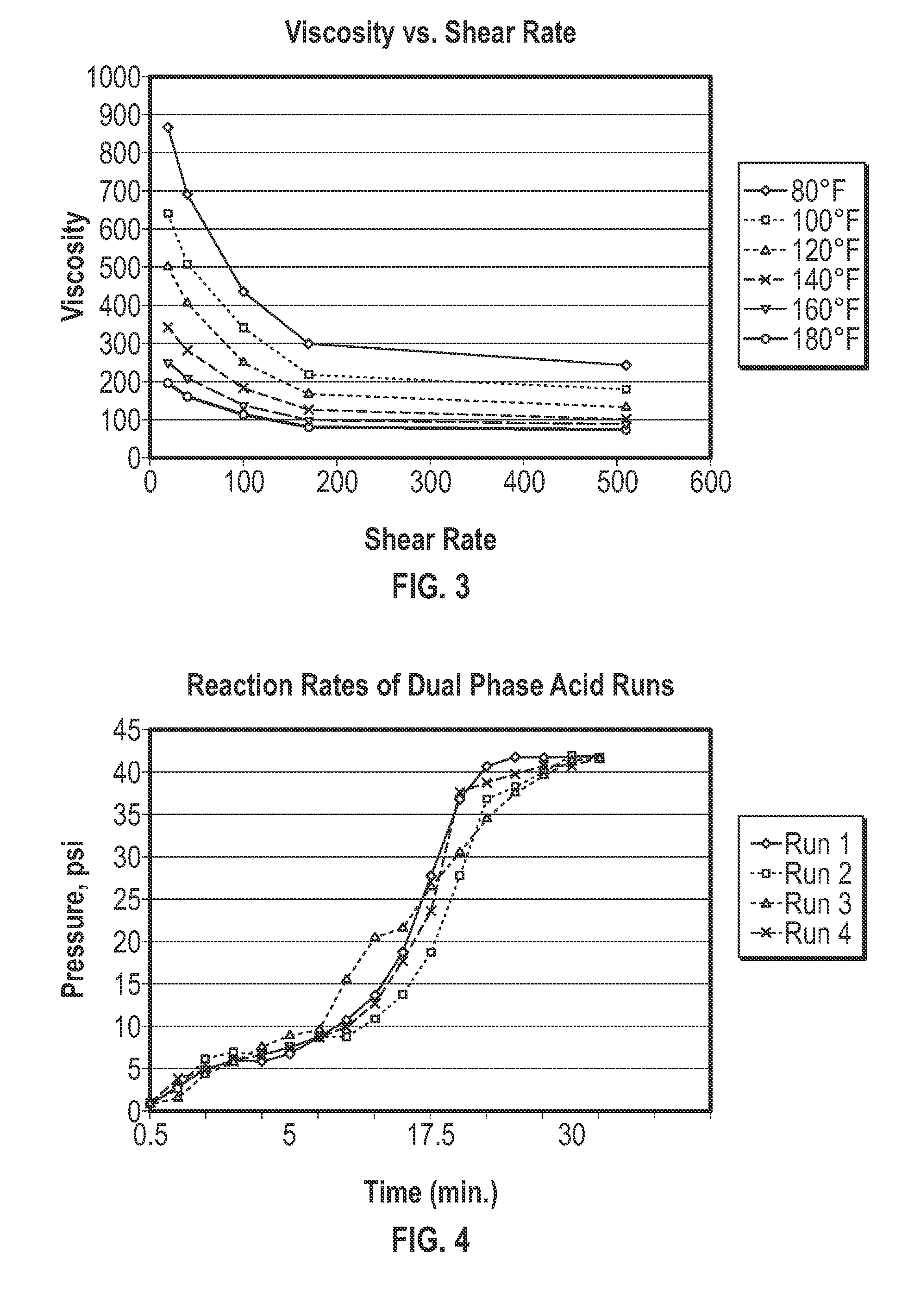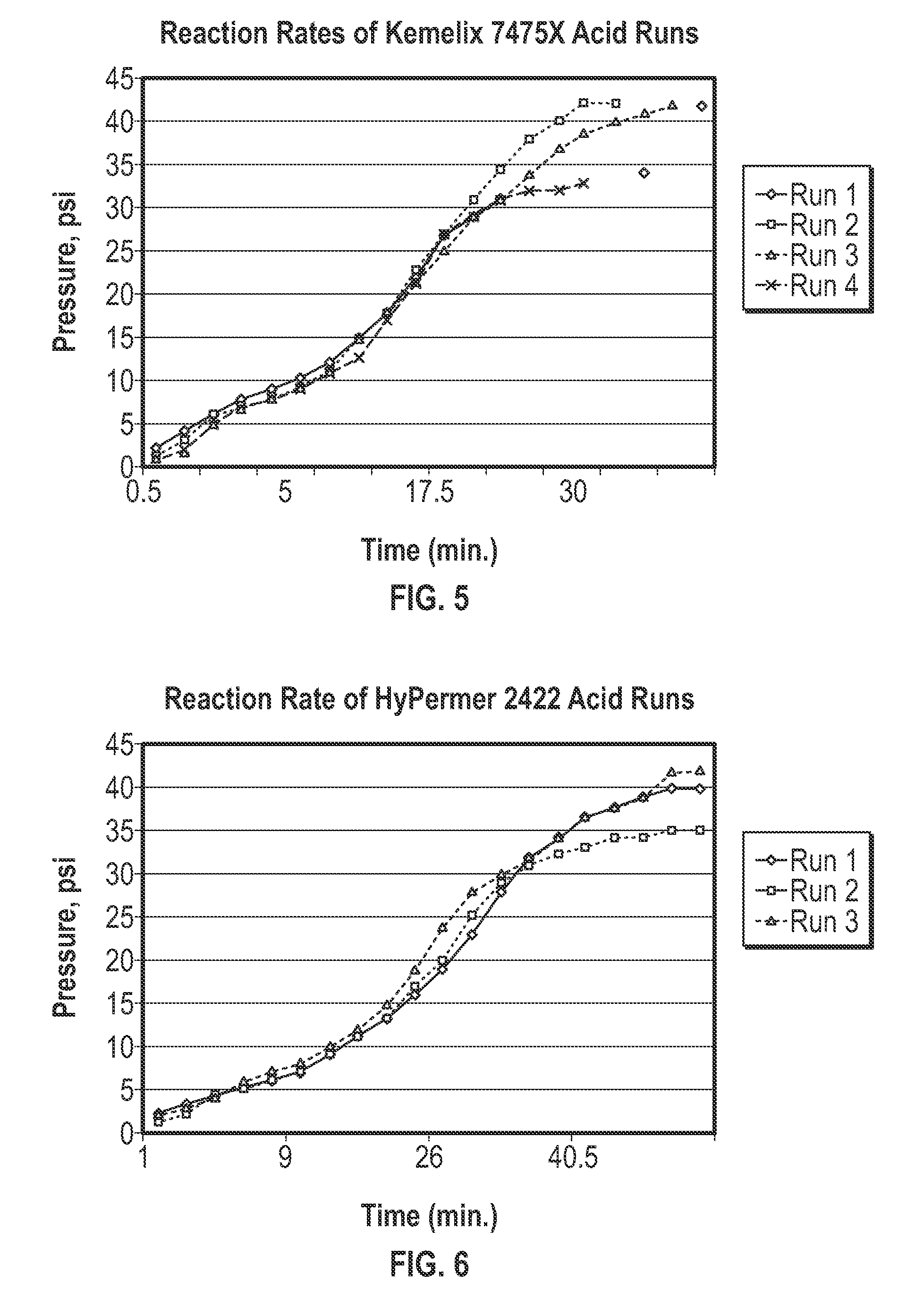Acid-in-oil emulsion compositions and methods for treating hydrocarbon-bearing formations
a technology of acid-in-oil emulsion and hydrocarbon-bearing formations, which is applied in the directions of transportation and packaging, sealing/packing, and wellbore/well accessories, etc., and can solve the problem of limited increase in hydrocarbon production
- Summary
- Abstract
- Description
- Claims
- Application Information
AI Technical Summary
Benefits of technology
Problems solved by technology
Method used
Image
Examples
example 1
[0066]This example was conducted to demonstrate the heat stability of the acid-in-oil emulsion composition at varying temperatures. In this example, the emulsifying agent used in Sample 1 was a PIBSA alkanolamine. The emulsifying agent used in Sample 2 was a PIB ethanolamide. The base oil used in Sample 1 and Sample 2 was Bio-Base® 300 base oil, a mixture of blended linear paraffin (93%) and olefin available commercially from Shrieve Chemicals Co. The dispersion agent used in both Sample 1 and Sample 2 is an ethoxylated natural fatty alcohol based lauryl alcohol. The acid used in Sample 1 and Sample 2 was 15% hydrochloric acid. Each of Sample 1 and Sample 2 also included a corrosion inhibitors commercially available form from Baker Hughes Company. Various types of corrosion inhibitors can be utilized in acid-in-oil emulsion system. In each of Sample 1 and Sample 2, the acid-in-oil emulsion composition was formulated by mixing 30% base oil, 30 gpt emulsifying agent, 3 gpt dispersion ...
example 2
[0068]This example was conducted to demonstrate the low viscosity of the acid-in-oil emulsion composition when compared to a commercially available acid-in-oil emulsion. In this example, the acid-in-oil emulsion compositions disclosed herein were compared with a commercially available acid-in-oil emulsion which contains priority pollutants. Sample 1 and Sample 2 were prepared according to Example 1. Each of Sample 1 and Sample 2 are devoid or substantially devoid of priority pollutants. Sample 3 was formulated as a comparative sample by mixing 30% red diesel base oil, 20 gpt E-31® emulsifier, 70% acid (15% HCl) and 2 gpt CI-25® corrosion inhibitor. Both the E-31® emulsifier and the red diesel base oil contain priority pollutants in amounts which exceed the limits established by the EPA.
[0069]The fluid viscosity of each of the samples was measured at different shear rates of 20 1 / sec, 40 1 / sec, 100 1 / sec, 170 1 / sec, 511 1 / sec and at varying temperatures of 80° F., 100° F., 120° F., 1...
example 3
[0078]This example was conducted to demonstrate the rate of acid retardation of the acid-in-oil emulsion compositions described herein. Each of Sample 1, Sample 2 and comparative Sample 3 were tested to determine their reaction rates with calcium carbonate. The acid reaction rates of each sample were measured separately in a closed system. A 10 or 20 millimeters of the sample was placed inside a polypropylene jar. Next 1.7 grams of calcium carbonate was then quickly added on top of the sample and the polypropylene jar was closed and connected to a 0-45 psi pressure gauge. The pressure gauge measured the generated CO2 gas pressure over time at 72° F. until a maximum pressure was reached.
[0079]The results of the acid reaction rate tests for comparative Sample 3 are summarized in FIG. 4, which is a graph depicting the pressure of the closed system over time. 20 ml of comparative Sample 3 was used in Run 1 and 10 ml of Sample 1 was used in each of Runs 2, 3 and 4. As can be seen from FI...
PUM
| Property | Measurement | Unit |
|---|---|---|
| Temperature | aaaaa | aaaaa |
| Temperature | aaaaa | aaaaa |
| Temperature | aaaaa | aaaaa |
Abstract
Description
Claims
Application Information
 Login to View More
Login to View More - R&D
- Intellectual Property
- Life Sciences
- Materials
- Tech Scout
- Unparalleled Data Quality
- Higher Quality Content
- 60% Fewer Hallucinations
Browse by: Latest US Patents, China's latest patents, Technical Efficacy Thesaurus, Application Domain, Technology Topic, Popular Technical Reports.
© 2025 PatSnap. All rights reserved.Legal|Privacy policy|Modern Slavery Act Transparency Statement|Sitemap|About US| Contact US: help@patsnap.com



